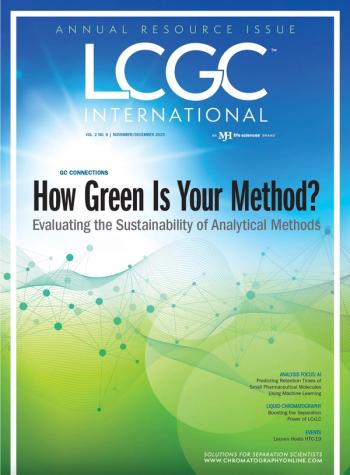
- The Column-01-20-2020
- Volume 16
- Issue 1
Early Alzheimer’s Diagnosis Using HSGC–IMS
Researchers have developed a headspace gas chromatography-ion mobility spectrometry (HSGC–IMS) method to detect volatile organic compounds (VOCs) linked to Alzheimer’s disease in faeces and urine.
Researchers have developed a headspace gas chromatography-ion mobility spectrometry (HSGC–IMS) method to detect volatile organic compounds (VOCs) linked to Alzheimer’s disease in faeces and urine (1).
As average life expectancy has risen across the globe so too has the rate of diseases for which age is a known risk factor. Dementia in particular has grown dramatically, with the most common form of dementia being Alzheimer’s disease (AD). Most individuals with AD are 65 and older with the risk of Alzheimer’s doubling every five years, and reaching nearly oneâthird after the age of 85 (2). There are, of course, many other factors in the development of AD ranging from genetics to environment, but ultimately there are roughly 50 million AD sufferers across the world, equivalent to countries such as South Korea or Spain (1).
AD sufferers show a gradual loss of cognitive function, an often slow and painful degradation that leads to the eventual failure of bodily functions (3). It is currently believed that the disease is caused by the abnormal aggregation of the protein beta-amyloid (Aβ) and tau proteins. An early diagnosis of AD helps significantly in slowing the disease’s progression because drugs can be used to intervene before serious brain damage can occur, but this is often not possible with current diagnostic methods. In fact, it is believed that cell degeneration in AD patients may occur many years before the onset of clinical symptoms and the diagnosis of AD much too late than would currently help with disease treatment.
Analysis of VOCs has proven to be an effective diagnostic tool in other diseases and, with more knowledge regarding AD suggesting metabolic pathways, it would seem to be worth investigating. Researchers analyzed VOC profiles in the faeces and urine of AD model mice using headspace solid-phase microextraction gas chromatography–mass spectrometry (HSâSPME-GC–MS) and HSGC–IMS.
Both techniques successfully identified VOCs in the faeces and urine of AD-model mice distinguishing between VOCs among different groups. The partial least squares discriminant analysis (PLS-DA) models developed by HSGC–IMS and HS-SPME-GC–MS could identify AD, however, the GC–MS model was not as accurate as that of GC–IMS. Researchers concluded that because of the low time cost and high predicative accuracy of the technique, GC–IMS could be used as a supplementary technique for GC–MS to achieve an accurate diagnosis quickly.
References
- H. Tian et al., J. Chroma. A DOI.10.1016/j.chroma.2019.460717 (2019).
- https://www.alz.org/alzheimers-dementia/what-is-alzheimers/causes-and-risk-factors
- Z. Nagy et al., Dementia 6, 21–31 (1995).
Articles in this issue
almost 6 years ago
Tips & Tricks GPC/SEC: Silica Versus Polymer‑Based Columnsalmost 6 years ago
SepSolve Analytical Relocates Headquartersalmost 6 years ago
Internationally Developed Seafood Safety Protocol for Toxin Analoguesalmost 6 years ago
Achieving Highly Sensitive Dioxin Analysis with Novel GC–MS Methodsalmost 6 years ago
Vol 16 No 1 The Column January 2020 Europe & Asia PDFalmost 6 years ago
Vol 16 No 1 The Column January 2020 North American PDFNewsletter
Join the global community of analytical scientists who trust LCGC for insights on the latest techniques, trends, and expert solutions in chromatography.



